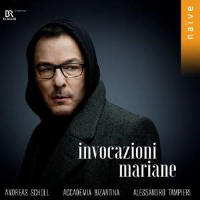Texte paru dans: / Appeared in:
|
|
|
|
|
|
‘Porpora, rival of Handel, mentor of Haydn, is worth exploring’ is how I ended my review of the DVD of the serenata L’Angelica (Dynamic, 3/23). Since then, David Vickers has praised CD recordings of the operas Carlo il Calvo and Polifemo (Parnassus, 8/23, 2/24). And here is our man again, opening an excellent disc of Marian pieces from Andreas Scholl and Accademia Bizantina, led and conducted by Alessandro Tampieri.
The Triumph of Divine Justice (1716) starts with a substantial overture, suggesting that there is more to the oratorio than the two arias included here. But who knows? The booklet is remarkably uninformative. The dotted opening, startling in its directness, leads to a fast section in triple time, followed in turn by a chromatic slow passage and a quiet conclusion. The first aria, ‘Occhi mesti’ (‘Grieving eyes’) is slow and chromatic, too, starting with imitative entries on the strings and ending on an open fifth; while the second, ‘Per pietà’, is preceded by an initially violent accompanied recitative.
As with the Porpora, the arias by Leonardo Vinci (1690-1730) present the Virgin Mary in the first person. ‘Chi mi priega’ (‘He who prays to me’) is a slow, gentle aria, accompanied only by continuo and an obbligato cello, beautifully played by Alessandro Palmeri. The strings enter in ‘Tutti son del materno mio seno’, addressed to Mary’s sons; and so does a pair of recorders, giving the piece a pleasantly pastoral feel. With Salve regina it is we, the children of Eve, who are pleading with Mary. The name Pasquale Anfossi crops up from time to time on account of the arias that Mozart composed for insertion in two of his operas. His setting of Salve regina dates from 1779 and is a world away from the rest of the music on the disc. ‘Salve regina’ is a cheery minuet, while ‘Ad te clamamus’ and ‘O clemens’ end with a cadenza over a six-four chord, the latter section including a phrase with a disconcerting resemblance to ‘Early one morning’.
The only relatively familiar piece is Vivaldi’s Stabat mater, RV621 (1721), as intense as Porpora’s Il trionfo. The most vivid movement is ‘Eia mater’, with its jagged phrases in the upper strings and the absence of a bass line. Andreas Scholl describes Mary’s sorrow movingly throughout, but with a touch of Purcellian skittishness in the dotted rhythm at ‘poenas’ in ‘O quam tristis’. (Robin Blaze is smoother here but no less heartfelt overall – Hyperion, 4/99.)
In the other pieces, Scholl sings with a grave beauty, with impeccable intonation and no changes of gear. An expressive intensification on the first word of Salve regina and perfectly judged roulades on ‘compagna’ and ‘convertare’ in, respectively, the Vinci and Anfossi are just a few of the delights. The Sinfonia by Vinci gives Tampieri the chance to shine as violinist rather than conductor, as of course does the Pergolesi concerto. The interview in the booklet promises a third instrumental piece, a sonata by Angelo Ragazzi; but you will search in vain for it on the album. |
|




